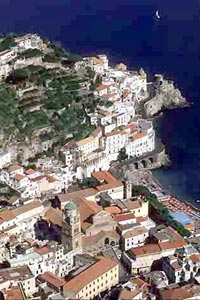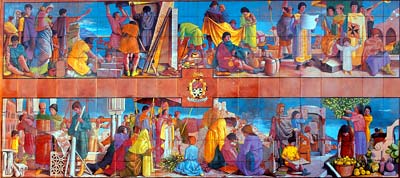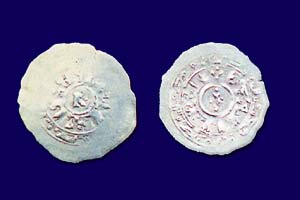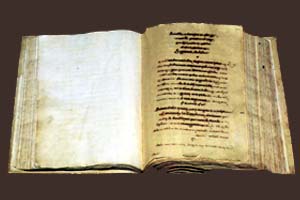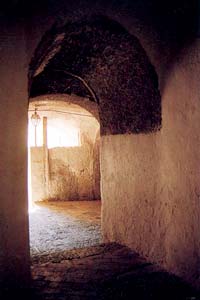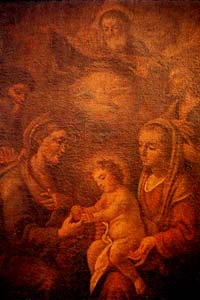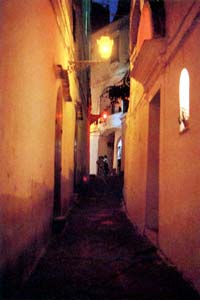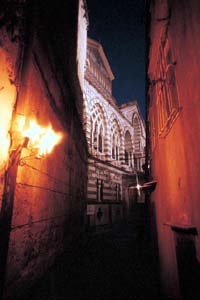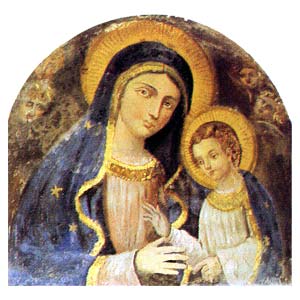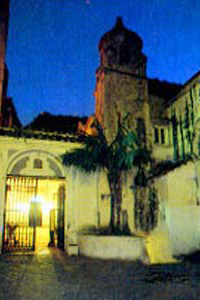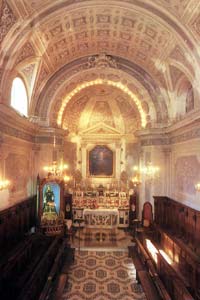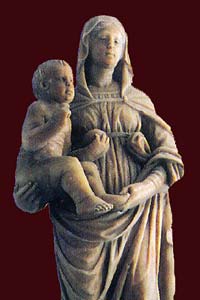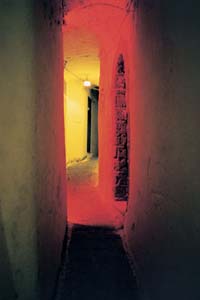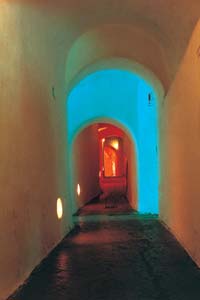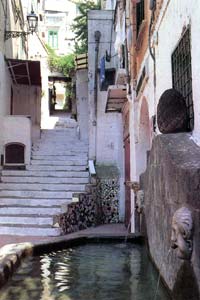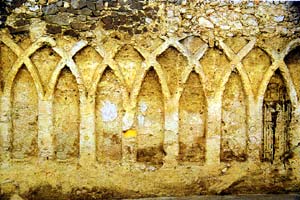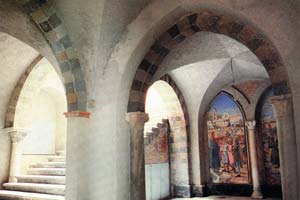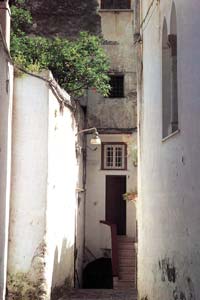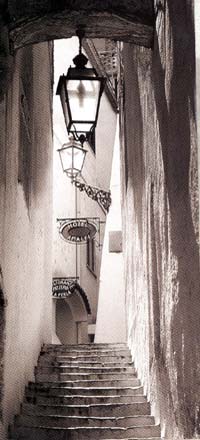| Red route» A VISIT TO THE HISTORICAL TOWN CENTRE |
Time: about three hours Difficulty: medium |
| Printable Version | |
Via delle Repubbliche Marinare » Pannello di Diodoro Cossa » Piazza Municipio » Supportico S. Andrea » Cappella di S. Anna la Piccola » Largo Filippo Augustariccio » via dei Prefetturi » Chiesa di S. Anna » Chiesa di S. Maria Maggiore » Chiesa dell’Addolorata » Salita Bonelli » via S. Simone » salita A. Tirabassi » Chiesa di S. Lucia » Supportico Rua » Piazza Spirito Santo » Ruderi della Chiesa di S. Spirito » Palazzo Castriota » via F. M. Pansa » via Ercolano Marini » Chiesa del Carmine » vico dei Pastai » via Mastalo Duca » salita Ruggiero II » Chiesa di S. Giuseppe » Piazza dei Dogi
The Tourist Office where we now find ourselves is housed in the famous Benedictine monastery of the Sacred Trinity that dates from the fifteenth century, today called St. Benedict’s Palace, also situated in these premises are the post office, the Town Hall and the Communal Library… Outside the entrance to the Tourist Office we take Via delle Repubbliche Marinare until we reach
the Ceramic Panel Designed in 1968 by Diodoro Cossa,
it depicts in a series of scenes the most important moments in the
history of Amalfi. After the panel we go left to the Piazza Municipio
also called “Campolillo”, the ancient quarter of St.
Angelo intra Moenia ( within the walls). Immediately inside the entrance we find “The Apocalypse of St. John the Baptist” work of Domenico Morelli, the sketch for the mosaics on the façade of the Cathedral in the renovation of 1891. Along the walls we can admire, a portrait of the historian of Amalfi, Matteo Camera by Pietro Scoppetta (1864-1927) an Amalfi- born artist exponent of the Posillipo school of Macchiaoli (impressionists), and a painting of Flavio Gioia , a portrait of P.Scoppetta by one of his pupils. At the back of the hall we find in a large wooden showcase examples of the “Tarì”, the ancient money of Amalfi;
nautical instruments; a rare printed copy of the “Pandette” of Corpus Iuris Civilis of Giustiniano, the original of which was plundered by the Pisans in 1135 and is now held in the Library Laurenziana in Florence. In the showcase we can also see a precious Codice Foscariniano, drawn up in the XVII century, and presented to the City of Amalfi in 1929, by Benito Mussolini who purchased it in Vienna. The volume includes the “Chronicon Amalfitanum”, the “Chronica omnium Archiepiscoporum Amalphitanorum”, the “Consuetudines Civitatis Amalfie”, and the most important the “Tabula de Amalpha”,, the first international marine code, that contains the 66 terms of contract of the inhabitants of Amalfi between the XI and XIV centuries…
Behind the showcase is the antique banner of the city, that is symbolized as “ a woman richly dressed in brocade”, in the cupboards nearby are the costumes of the Ancient Maritime Republic, worn on occasion of the Historical Regatta of the four Ancient Maritime Republics. The rowing competition between Amalfi, Pisa, Genoa and Venice, who alternately host the event yearly in the first week of June… On leaving the building, on the northern side of the square we find the ancient domus Campolillo, an aristocratic residence built in the XI century, and altered in XIII, it has an interesting entrance hall with a vault in the form of a cross… Entering the narrow passage of St. Andrea, on our left we find the entrance to the Communal Library “ Pietro Scoppetta”, this also houses the “Amalfi Centre of History and Culture”. A public cultural society, the Centre was created in 1975 to promote the study of the territory, and this important mission is achieved by conventions on local history and exhibitions of documents, and the availability of over 3700 volumes manuscripts and ancient printed matter that has an association with local history and culture… A few paces ahead and we find the secondary entrance to the Cathedral of St. Andrew, which we pass by following the narrow passage S. Andrea
we also pass the little Chapel of St. Anna, also called “ the dark one” from the sombre tones of the painting that adorns the altar ( it depicts St. Anna and the Madonna as a child).
We arrive in the Largo Filippo Augustariccio, which was called in the Middle- Ages Campo de Cinnamellis, where the spice merchants plied their trade, now we follow via dei Prefetturi…
Ahead of us we find the ancient Tribunal of the Piccolomini Dukes, today an old peoples home, the Chapel of St. Anna "the Great"
on the ground floor of the fourteenth century Mansion Bonito, now we move on into Largo S. Maria Maggiore and the Church of St. Mary Major with its beautiful Moorish bell tower.
Founded by Duke Mansone I in 986 but extensively renovated
in the baroque period, it holds many painting,
the body of St. Felice and a precious crib scene (Presepe) of the
seventeenth century, nearby the
Church of St. Mary Our Lady of Sorrows Founded at the end of the XVIII century, it contains a number of paintings of the sixteenth and seventeenth centuries, a marble statue of the XVI century depicting the Madonna and Child; a late gothic bas-relief of the Crucifixion, and a dead Christ of the renaissance period. The Church is seat of the Arch-confraternity of the same name, founded in 1777… The above mentioned confraternity organizes the Vespers
of Holy week, the moving procession of Battenti,
the white –hooded men who carry in procession the “Mysteries”,
symbol of the passion and death of Christ. They
open the “Way of the Cross” on Maundy Thursday,
a sad procession that in the roads of the town re-enact the stages
of the capture and passion of Christ. On Good Friday there is the
“ Funeral procession of Good Friday”,
that in the flickering pale light of torches escort the seventeenth
century statue of Our Lady of Sorrows and the dead Christ… Straight ahead we find Salita Bonelli which we climb until we reach via S.Simone, passing through the interesting alleys of this ancient ward Rione S. Simone,
after about a hundred metres we descend the narrow
steps of via Tirabassi where halfway down there is the little
church of St. Lucia, of the XII century…
At the bottom of the steps we find ourselves in the middle of Ruga Nova, the ancient passage way that before the river was covered at the end of the XIII century, was the only road that crossed the centre of the town…
Directly ahead we come to Piazza Santo Spirito
Originally called “De li Grassi” , this small square was once the extreme limit of the town centre and the Porta Hospitalis ( hospital gate) , barred the entrance, so called because the hospital of St. Maria Cruciferarum was founded there in 1213 by Cardinal Pietro Capuano. On the left of the square, on a high grey wall, we can see entwined arches, the remains of the cloister of the two hundreds that was part of the Church of the Holy Ghost, under the patronage of the paper manufacturers.
Further down the road is the entrance to Castriota Palace which we enter… This belonged in the XV and XVII centuries to the noble Albanian family Castriota – Eskanderburg, the most interesting part of the building is on the first floor, in the internal entrance hall there are two excellent frescoes by Ignazio Lucibello , pupil of Scoppetta. They were painted in the first thirty years of the last century and depict : “The speech of Roger the Norman to the Amalfi people and the taking of Jerusalem”. In the front there are the knights of St. John of Jerusalem , the hospital order founded by friar Gerardo Sasso in around 1113, that has since become the Sacred Order of the Knights of Malta…
Passing through a door situated on the next floor we arrive in Piazzale Campo and straight ahead along via Francesco Maria Pansa until the ruins of the ancient Convent of St. Nicholas (a chapel with an entrance that has a vault in form of a cross). Further ahead,
passing the Vicolo dei Pastai, we arrive in via Mastalo Duca
where we can see a series of majestic mansions of the nobility of the XI-XII centuries, and at the end of the covered passage on the right, the fifteenth century Chapel of St. Giuseppe de’ Castriota…
A few paces ahead and we arrive in the interesting Piazza dei Dogi, originally called Iron-workers Square because the smiths plied their trade there… A magnificent example of a medieval square, there
were once four churches here, as we can see from the remains of
the Church of SS. Quaranta Martiri on the western side and also
a part beside the great windows of the Ancient Arsenal on the opposite
side. On the left hand side of the square a narrow passage leads
us to Piazza Duomo. Our first sight-seeing walk finishes in this magnificent
square.. |
| Printable Version | X
Close |
